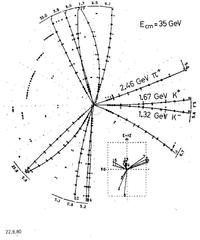3 jet event in the TASSO detector at PETRA: two quarks produced in an electron-positron collision emit a gluon; each of the particles turns into a jet of particles. Such a picture was the first direct evidence for the gluon.
Forty years ago, in 1979, a powerful particle first saw the light of day: the gluon, which holds together quarks and binds protons and neutrons, was discovered at DESY’s storage ring PETRA. It was on 18 June, at the particle physics conference “Neutrino 79” in Bergen (Norway) that Bjørn Wiik, a member of the TASSO collaboration at the time who later went on to become the director of DESY, presented the first image of the tracks recorded by the TASSO detector which displayed the signature pattern of a gluon. The image consisted of three particle jets that had been produced by two quarks and the gluon itself. Shortly afterwards, all four experiments at PETRA had also observed these characteristic three-jet images in their detectors.
“The discovery of the gluon is undoubtedly the most important discovery in particle physics to be made by DESY. It marked a breakthrough for the Standard Model of particle physics and served as a basis for quantum chromodynamics, the theory that so beautifully describes the strong interaction that is mediated by gluons,” explains DESY’s Director for Particle Physics Joachim Mnich.
The discovery was preceded by the construction of the PETRA collider at a pace that is a huge credit to an accelerator centre: in just two years and eight months, more than a year earlier than originally planned, the entire structure had been completed under the management of Gustav-Adolf Voss, without even having to use all the funds earmarked for the project.
Once it had gone into operation in the autumn of 1978, the beam energy was gradually increased and the four experiments – JADE, MARK J, PLUTO and TASSO – took their first readings in the early summer, at a collision energy of 27 gigaelectronvolts, enough to record individual gluons in their detectors.
In 1995, four scientists from the TASSO collaboration, who had analysed the first images of the gluon, were awarded the prize for particle physics by the European Physical Society for their discovery: Paul Söding, Bjørn Wiik, Günter Wolf and Sau Lan Wu.
Read more about the story behind the discovery of the gluon.








